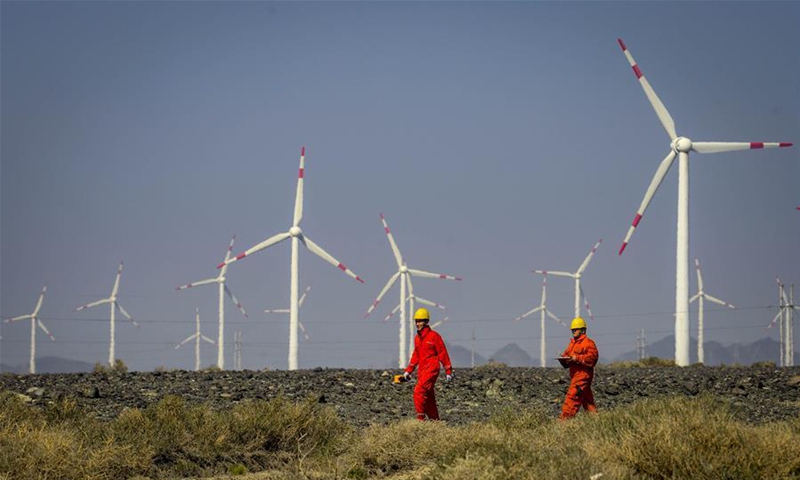Xinjiang region beefs up wind, solar power generation
Xinjiang sets record high wind, solar power generation, aims to be clean energy base in China

Workers check equipment at a wind power plant in Urumqi, northwest China's Xinjiang Uygur Autonomous Region. File photo: Xinhua
Northwest China's Xinjiang Uygur Autonomous Region is taking the lead in China's renewable energy push, with wind and solar photovoltaic (PV) power capacity reaching a record high of 35.83 Gigawatts (GW) that even outpaces some developed countries, analysts say.
Lin Boqiang, director of China Center for Energy Economics Research at Xiamen University, said that the total wind and solar PV electricity capacity in Xinjiang is larger than that in the UK, Belgium, Netherlands or Japan, citing data.
Lin noted that Xinjiang's advantages in developing new-energy electricity generation are its strong winds and long hours of sunlight. The total capacity of solar and wind power has climbed by 135 percent from 2015, reaching the cumulative amount of 35.83 GW, the Xinhua News Agency reported on Saturday, citing a source from the Xinjiang branch of the State Grid Corp of China (SGCC).
The new-energy installed capacity in Xinjiang is the second-highest among all provincial branches of the SGCC.
Vast land areas and low land costs in Xinjiang make it relatively cheap to develop new-energy sources, but distances between the locations of electricity production and consumption have caused problems in boosting the sector, Lin said.
With efforts to constantly upgrade power transmission, the volume of electricity sent from Xinjiang to other regions is planned to exceed 110 billion kilowatt-hours (kWh) this year, among which 27 billion kWh will come from new-energy generation, according to an announcement released by SGCC's Xinjiang branch.
Xinjiang aims to increase the new-energy installed capacity to 82.4 GW by the end of China's 14th Five-Year Plan (2021-25) period, per the local government's 2020 work report.
According to Lin, national wind and solar capacity is around 500 GW, and Xinjiang's 35.83 GW makes up a significant part of that. If the transmission sector and local markets improve, renewable energy will develop more rapidly.
New-energy electricity generation in Xinjiang reached 84.5 billion kWh and accounted for 24 percent of the total electricity produced in 2020, mostly attributed to solar power. It is equal to the energy consumption of 27 million tons of standard coal, which would have released 72.9 million tons of carbon dioxide.
Seeking to become a major clean energy base in China, the rapid development of Xinjiang's new-energy sector will greatly contribute to fulfilling China's goal of reaching a carbon dioxide emissions peak before 2030, and realizing carbon neutrality by 2060.
Global Times



